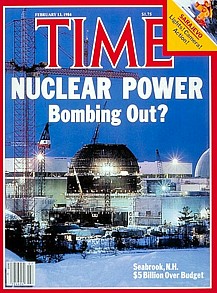Most countries are not building more nuclear power plants,
and some are shutting down some of the ones they have,
because Fukushima has confirmed what Chernoby and Three Mile Island
already told us: maybe the physics is sound, but the business
model leads to unsafe plants.
But in the U.S. and Georgia, it’s full speed ahead for new nukes,
regardless of the risks of radiation leaks or cost overruns.
Christopher Joyce wrote for NPR today,
After Fukushima: A Changing Climate For Nuclear
“We don’t see Fukushima as having a significant impact on the
 U.S. industry,” says Scott Peterson, vice president of the industry’s
Nuclear Energy Institute. “The Nuclear Regulatory Commission was renewing
10 licenses for U.S. plants, extending them 20 years in operation. We
were continuing to move forward in examining new reactor designs.”
U.S. industry,” says Scott Peterson, vice president of the industry’s
Nuclear Energy Institute. “The Nuclear Regulatory Commission was renewing
10 licenses for U.S. plants, extending them 20 years in operation. We
were continuing to move forward in examining new reactor designs.”
Nevermind that those extensions mostly go well beyond the design
lifespans of the plants extended.
Marc Chupka, who advises electric utilities as an economist with the
Brattle Group in Washington, wonders who’s going to pay for them.
“Right now, just the plain economics of nuclear power are
underwater,” he says. He notes that over the past decade,
construction costs have skyrocketed and natural gas got more
plentiful and cheaper.
“Things change significantly over relatively short periods of time,”
Chupka says, noting that it takes about a dozen years to plan and
build a new nuclear plant. “That makes it an incredibly challenging
environment to plan for the long term. And that adds to the risk and
it makes investors understandably skittish.”
So we could do what Germany is doing:
Germany says the same: The government will throw its weight and
wealth into solar and wind energy to replace nuclear power.
Or we could listen to the same old excuse:
Continue reading → On March 28, Bulgaria officially announced the cancellation of its newest nuclear power plant (NPP) “Belene” construction. The Parliament has stopped this controversial project after years of discussion and more than half a billion euros invested in the construction of the first reactor.









